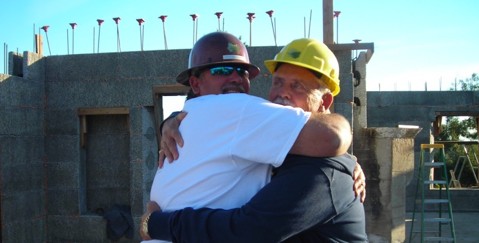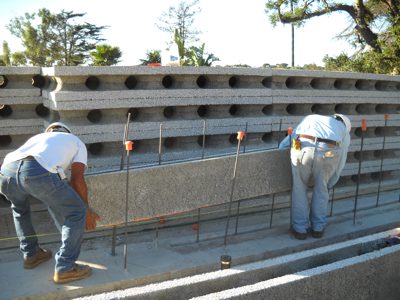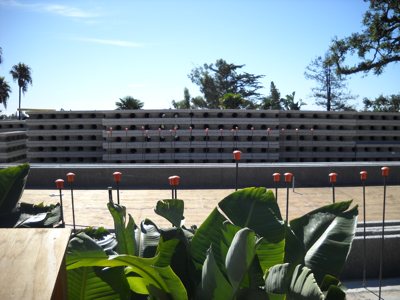From the Ground Up
Some Santa Barbara Fire Survivors Are Choosing to Rebuild Their Homes Greener and Safer

When Santa Barbara is featured in the national news, it is far too often because of our dangerous wildfires. The most recent examples include the Gap, Tea, and Jesusita fires, which demonstrated the horrific damage that can be caused by these natural disasters. Hundreds of homes were lost in these infernos — including 210 homes destroyed in the Montecito Tea Fire alone. But the owners of these houses lost more than material property; in many cases they lost everything, including their livelihoods. With the expensive costs of rebuilding a home and replacing furniture and cars, and the loss of other important personal property such as photos and family heirlooms, it is no wonder that this can be an emotionally charged time for the survivors. Thankfully, these families have some hope of rebuilding in a cost-efficient and timely manner thanks to generous donations, volunteers, and helpful private companies like Green Building America.

For some people, the devastating effects of the Santa Barbara Tea Fire were all too real. The Santandrea family home (a Santa Barbara landmark built in 1929 and sadly destroyed in the Tea Fire) was originally created by a prominent designer in the traditional Spanish-Mediterranean style that Santa Barbara is famous for. I had the opportunity to speak with Carmine Santandrea regarding his unfortunate loss and the steps he and his family are taking to rebuild the spectacular home. “At first I was upset with the police and fire departments,” Santandrea said, “but then I realized that they cannot handle everything. I decided that it’s time to take responsibility for my property’s well-being as I am responsible for my health.”
Santandrea is referring to the material out of which his new home is to be built. The family has a goal of recreating their home with the exact same aesthetic design as the 1929 construction, but thanks to Green Building America, they are doing it for less money and out of completely fire-resistant materials. The material, which has been used to build homes for almost 50 years, is called hybrid block. Hybrid block, also called insulating concrete form (ICF), is not only fire resistant and noncombustible, but it is also composed of 85 percent recycled polystyrene (Styrofoam) and 15 percent recycled cement, making it one of the most green ways to build a home. Santa Barbara has been a leading city in the environmental movement, so it is obvious that this eco-friendly, fire-resistant material is gaining popularity among our residents.

Penn Estes, CEO of Green Building America, gave me a tour of a home being built with hybrid block. “I came at this from a perspective of ‘there’s got to be a better way,’” she stated. A survivor of an illness caused by black mold, Estes looked to hybrid block originally as a way to combat the mold, mildew, termites, and other infestations that can be problematic when using lumber to build homes. Little did she know that, in Santa Barbara and other areas prone to extensive wildfires, the fire-resistant properties of hybrid block would be the driving force behind its success. I spoke with retired Santa Barbara Fire Department battalion chief and Santa Barbara local John Ahlman regarding the safety of these new buildings. Ahlman began by describing the difficulties of fighting a fire in Santa Barbara’s mountainous terrain, “When it is a wildfire, you can’t be everywhere … having more houses built of hybrid block is great for the fire department — it buys us a lot of time.” I also spoke to another survivor of the Tea Fire who wishes that she had learned about hybrid block earlier, as her family’s home was among the first to burn.
Kareen Hart and husband Kevin lost everything in the fire; they are now living with their family of four, pet dog, and birds in two trailers on their property as the rebuild progresses. They chose to rebuild using hybrid block because of what the Harts described as “low impact construction as well as the vastly reduced fire risks.” The Hart family, whose home was photographed in flames on the cover of the LA Times the day after the fire, was horrified at the damage caused but say they remain grateful to Green Building America for assisting in a cost-efficient rebuild of their old home.
By using hybrid block — as opposed to forest lumber — Green Building America says it and its clients have saved 837 acres of virgin forest. This number will reportedly continue to grow with each build. The homes are reportedly not only composed of 100 percent post-consumer content, but also help reduce home emissions (and maintenance costs) because of the superior insulation that calls for less heating and cooling in the home. For Santa Barbara residents, as it was for leaders of the Green Movement, building a home that saves the environment and does not contribute to deforestation is a perfect fit, and for the men and women who lost so much in the Santa Barbara fires, getting a chance to rebuild in a safer and less costly manner is a well-deserved bonus.



